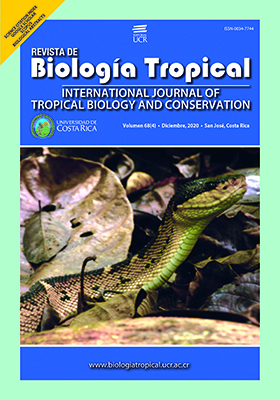Abstract
Abstract: Flatfish diversity and depth distribution in the Gulf of Nicoya, Golfo Dulce, and two adjacent areas on the Pacific coast of Costa Rica. Introduction. Information on flatfish diversity and depth distribution is scarce for the Eastern Tropical Pacific. Historical data is important to evaluate changes in ecosystems due to local, regional and global stressors. Objective. To provide information on the presence, depth distribution and lengths of flatfish species collected by trawl nets. Methods. Fish studies were conducted by trawling at four sites along the Pacific coast of Costa Rica by the survey vessels Skimmer (1979-1989), Nishin Maru (1987-1988) and Victor Hensen (1993-1994). The published lists of species were consulted, museum specimens were accessed, and a list of flatfishes assembled. Results. A total of 36 species were found at the four sites over a depth range of 8 to 359 m. The family Paralichthyidae included 13 species followed by the Cynoglossidae with 12 species. Achiridae had six and Bothidae had five. The most speciose genus was Symphurus with 12 species. Thirty-five species were collected at depths from 10 to 235 m in the Gulf of Nicoya and Golfo Dulce. The Gulf of Nicoya estuary yielded 27 species during the Skimmer expedition and over a depth range of 8 to 60 m, while 31 species were found there during the V. Hensen survey at depths from 10 to 228 m. The V. Hensen survey in Golfo Dulce (20 to 235 m) captured 19 species, and 17 in Coronado Bay (21 to 187 m). Off the Nicoya Peninsula (56 to 359 m) 13 species were collected by the Nishin Maru shrimp trawler. A total of 21 species (58 %) were found at depths greater than 100 m and were probably exposed the low oxygen concentrations characteristic of hypoxia. During the V. Hensen survey Symphurus chabanaudi and S. elongatus were captured more frequently in the Gulf of Nicoya, while S. leei was so in Golfo Dulce. Cluster analyses based on presence-absence data for the Gulf of Nicoya and Golfo Dulce revealed low station similarity indicating habitat partitioning among the species. The size (Total length) of 33 species measured from both the Gulf of Nicoya and Golfo Dulce ranged from 8 cm (Syacium cf longidorsale, Trinectes xanthurus) to 50 cm (S. ovale). Only 12 species were found with lenghts over 20 cm. Of the species collected, A. mazatlanus (30 cm) and S. ovale (50) appear to be length records for the region. Data on flatfish landings by the semi-industrial fishing fleet for the period 2000-2016 indicates that this group represents less than 1% of the total landings (shrimp and bycatch), with a minimum of 365 kg in 2001 and a maximum of 13.414 kg in 2013. Conclusions. The diversity of the flatfish fauna of the Pacific coast of Costa Rica appears relatively high but comparable to that found in other tropical regions. The number of trawling ships has declined significantly on the Pacific coast of Costa Rica after 2014. This reduced fishing impact on the populations provides a good opportunity for updating the trophic models available for both the Gulf of Nicoya and Golfo and their use as tools for better management of the ecosystems.
##plugins.facebook.comentarios##

This work is licensed under a Creative Commons Attribution 4.0 International License.
Copyright (c) 2020 Jose Vargas, Ana Rosa Ramírez, Berny Marín, Myrna López, Matthias Wolff


